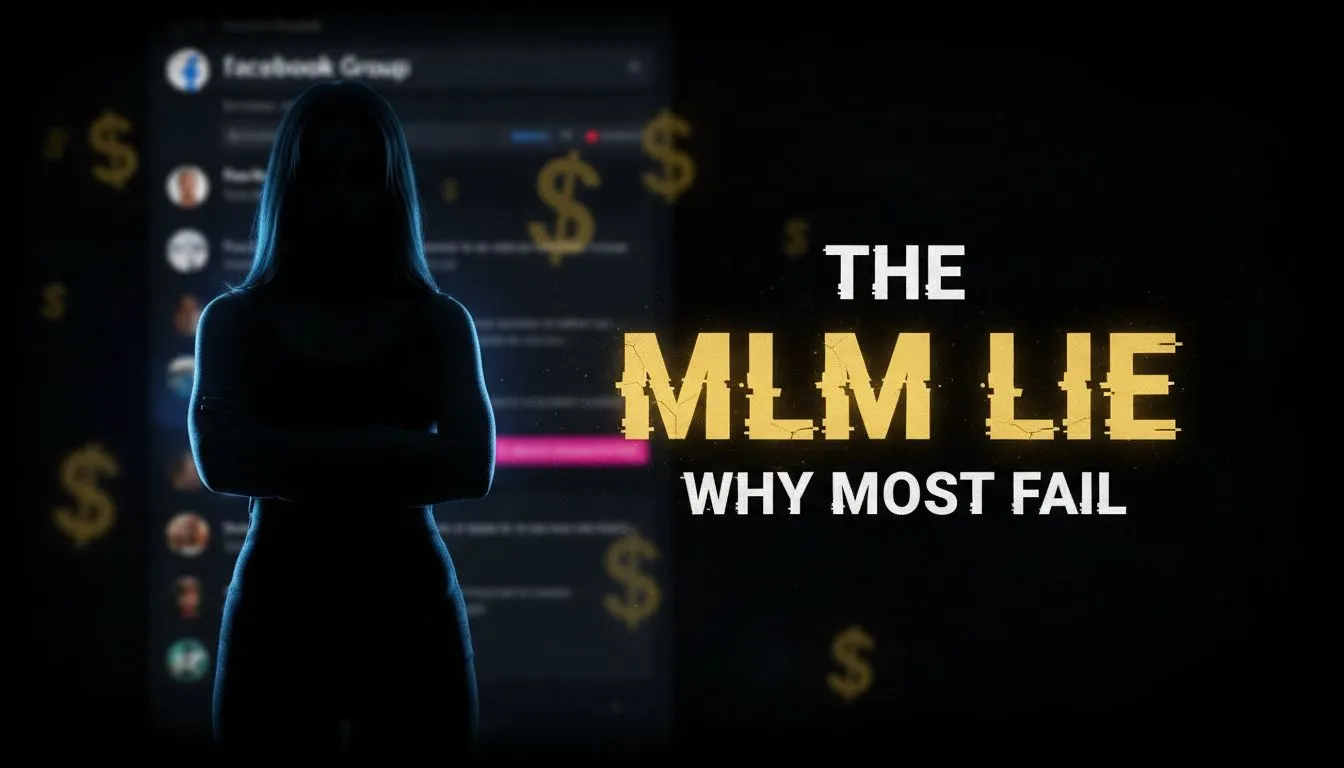Affiliate Marketing vs MLM (Which Business Model is the Best For You?)
In this article, I'll discuss affiliate marketing vs MLM. By the end of the article, you'll get a better idea about the differences, the compensation structures, and which one fits your lifestyle the best.

Affiliate Marketing versus MLM, also known as multi-level marketing and network marketing. You might be wondering which one is better for you, which can make the most money or be beneficial within your lifestyle.
I’ll be covering these 2 different models as well as my personal opinion of which can help you grow a business globally or even make you more money. Let’s talk about the first one, affiliate marketing.
Table of Contents
- 3 Ways to Get Paid
- Single Tier Affiliate Programs: How to Make Money by Promoting Other Peoples Offers
- The 2-Tier Model: Make Money with Single Level Overrides
- Just a Quickie About Affiliate Networks
- Multi-tier: Earning Commissions from Multiple Levels
- Following the System for MLM Success
- The MLM Commission Structure
- The Higher the Margins, the Higher the Commissions
- Which Business Model Fits Your Lifestyle and Is Best For You?
- Creating Multiple Streams of Income
3 Ways to Get Paid
Affiliate marketing has 2 major ways of making money, and that is through single tier and 2-tier programs.
The 3rd one is called multi-tier (AKA MLM / Network Marketing).
This tier is equivalent to a level. Multi-tiered can be considered multi-level marketing. And within multi-level marketing, there are many compensation structures. But the main thing is that you’re able to earn commissions across multiple tiers.
Single Tier Affiliate Programs: How to Make Money by Promoting Other Peoples Offers
Let’s talk about the basic type of affiliate marketing model, the single tier model.
As an affiliate marketer, Bruce ends up enrolling in an affiliate program to promote a TV and then the sale of that TV is able to earn a commission of 3% for every sale. So I end up going to one of the most popular e-commerce shops, enroll in their program, and then I start promoting this TV. Let’s say it’s a 52-inch TV and it’s a high priced one that goes for a $1,000 dollars. We’re using $1,000 dollars just to keep the numbers simple.
So in this example, $2 is 3% of that. $1,000 dollars.
So every TV that I sell for this specific model, I will make thirty dollars (at 3% commission rate) and then I’ll go ahead and start creating blogs or even videos to promote this TV.
Then you might be wondering, that’s a very expensive TV! Not a lot of people will buy it. But I have to say that there are many people out there and there are ways to do research where you can see the demand. And let’s say that this TV has over 10,000 searches a month on the internet.
So even though I’m not able to capture all those people that are searching and buying, I can capture a fraction.
Let’s say a fraction of those end up buying from me and let’s say that that fraction is 10 people. I know that this seems like a small amount of people. But from my website, I’m able to promote this passively. Then ten people buy every month and then at a commission of thirty dollars, that means I’m making $300 from that TV every month.
And of course, every product out there has its life cycle. And there might be some peaks and valleys depending on the season. Also, new models will come in. I’ll continue to do research and find which ones have a good trend line. You can go to https://trends.google.com if you want to look at trends. Using this model, I can promote and make money from this TV, as well as many other products and services.
So hopefully you got that idea that it’s just another version of word of mouth, but more digital.
Of course, I can communicate to people directly if I wanted to, but I realized that through the power of the Internet, I can promote this online and communicate through this modern medium to many people around the clock.
The 3 types of mediums that you can easily communicate with online are blogs (written), YouTube (video), and podcasts (audio).
So far I’ve talked about the single tier model just. This allows you to only make commissions off of selling a product or service.
The 2-Tier Model: Make Money with Single Level Overrides
Now, let’s discuss how you can make money using the 2-tier model. What’s happening is that a referring affiliate will earn a commission off of another affiliate. In MLM, people call that an override. This is called 2-tier model, but you only make money off of a single level.
Here’s an example of the 2-tier model.
Let’s say I’m promoting these TVs and then one of the affiliates ends up checking out my promotional videos or blogs posts.
Then that person clicks through my affiliate link, and then they go to the merchant website (the e-commerce store). That person realizes that they want to promote the product too. So they sign up as an affiliate.
With this system, the technology will be able to track that the relationship so that affiliate becomes a sub-affiliate under my account. Let’s say the name of Bruce’ sub-affiliate is Lisa.
So what will happen is that Lisa will earn her commission from the sale of that TV. Let’s say that it’s 3%. She’ll make $30 per a sale for that $1,000 TV. What will happen is that as an affiliate, sub-affiliates can also earn 3% from their personal promotions and the referring affiliate will earn a smaller commission (an override). Let’s say that that affiliate program specifically says that affiliates will make 3% on the first tier and then on the 2nd tier make 0.5% (the override).
So if Lisa makes a single $1,000 TV sale and earns a $30 commission for each sale, Bruce would make $5. If 10 TV’s were sold through her affiliate link, she would make $3000 and Bruce would make $50 through the override.
So far, we’ve talked about the 2 most popular affiliate commission structures.
I also want to mention that most of these affiliate programs are free to join. There are no monthly or annual membership fees, or quota requirements. There are some private affiliate programs that I’ve joined that do require some fees. Sometimes these are called licensing fees which allow a small group of affiliates to promote private offers.
Just a Quickie About Affiliate Networks
Some stores offer their affiliate programs, and some belong to affiliate networks. As an affiliate, you can join this affiliate network that is connected with many merchants (AKA vendors / online shops) and then you’re able to promote multiple products across multiple companies within this big network.
This network is in charge of using a technology. They have their affiliate technology, and these stores implement the affiliate tracking system within their stores. This allows affiliates to track sales and their commissions. Typically, these affiliate networks will pay commissions directly to affiliates.
It’s kind of technical, but the main thing is that you can sign up for multiple stores within one network versus just signing up for a single affiliate program where you can only promote for 1 store. When I say one store, I’m not referring to being captive or anything like that. You still have the choice of being able to promote many offers from a variety of shops.
Multi-tier: Earning Commissions from Multiple Levels
Let’s discuss multi-tier now! For me, multi-tier affiliate programs and MLM are the same. The main thing is that you can earn overrides from more than 1 level (the 2nd tier).
The majority of these programs to have a fee. They’re also extreme newbie friendly as they offer membership kits to help people create their businesses from scratch. Most affiliate programs don’t charge fees and don’t offer new member kits.
Most people that I’ve met in MLM have never ever created a business before. So having a single system helps representatives follow a successful path.
Following the System for MLM Success
In the MLM industry, there are traditional and modern network marketing companies. Traditional companies typically are opportunity meeting heavy.
Through these meetings, they’ll use this process that’s duplicated where there’s going to be 1 or more leaders at the opportunity meeting talking on a stage.
There’s typically a lot of excitement in the meeting. The representatives (AKA distributors) will invite their warm market (their friends and family) to these meetings, and then they get sold on a product, service, or the business opportunity.
That’s typically the traditional model for multi-tier and the primary approach for recruiting people into the company. These companies typically focus on event promotions. Every week there’s at least 1 event that representatives invite their audience into, then there are larger events. These can come in the form of a large annual event or regional events.
With the traditional approach, it’s typical advised that everyone follow the primary system. One of the reasons why is not just because it makes a lot of money, it’s also a way to streamline legal compliance.
A lot of representatives that are not schooled on compliance, on selling online, or in person, might do a lot of shady tactics. That applies to any businesses out there, not just MLM. By providing a tightly controlled system, marketing can be maintained and sustained over time.
The MLM Commission Structure
For most traditional network marketing companies, create a warm list, your friends and family members and contact them and then be able to provide products and services or even opportunities to them. That is just the difference in how it’s marketed. But the difference in commissions is that multi-level marketing (MLM) has a variety of ways to get compensated. Some compensation structures might be more attractive than others. Some companies might have something called a binary, a matrix, a unilevel, or stairstep breakaway. There are so many ways to get paid nowadays with the emergence of innovative technology that can easily track these various commission structures and hybrids.
Some companies can have a basic 3 level model, a 10 level model, or even a 20 level model. The more tiers (levels), the smaller commission percentages. They’re pretty much slicing up the commissions that we talked about in the 2-tier model, and splitting it across more levels for the ability to override more people. That’s another big difference with multi level or multi-tier programs compared to single and 2-tier affiliate programs.
Here’s an example of a multi-level payout.
Let’s say, we’re still using this television set example. Lisa makes 3% and then Bruce might make like a smaller percentage like 0.3% and then the person that referred Bruce to the company will make 0.2%, whoever referred me. That’s just an example of how a company can pay distributors across 3 levels.
Some companies have very generous commission structures. The idea of getting an override across a huge team is a big draw. The main goal in my mind is to create a rock-solid, lucrative passive income stream.
The Higher the Margins, the Higher the Commissions
What happens is that products with high margins are promoted because of this model that I just shared with you in multi-tier. If the company is only promoting popular electronics, the margins will be smaller. A company might have a 15% markup for electronic goods, the the commissions would be small (ie. 3%).
Let’s say that you’re promoting something that has a high margin, such as a nutritional supplement. If you’re promoting nutritional supplements, a single bottle could for sold for a price amount like $10, or $20, even all the way up to $100 per bottle.
In fact, if the company buys these bottles at high volume, it might only cost them 50 cents per bottle. You can see the margin is huge and there are other types of products and services out there that have huge margins as well. I used to work in a financial services network marketing company and the commissions were typically in the 4-5 figure range.
When you’re promoting a company that’s got a high ticket offer, whether it’s finance or travel, there’s a lot of commissions to be made and there are larger dollar amounts across the multiple levels.
Which Business Model Fits Your Lifestyle and Is Best For You?
We’re going to get into the final topic here, which is which one is the best for you? This is more of a personal choice. It’s dependent on your lifestyle.
For example, let’s say that you don’t have that much time in the day. In this example, you’re working graveyard hours when a lot of the people that you associate with outside of work are typically asleep during the time that you have available. Also, your workplace is extremely strict, and they have a zero-tolerance policy for talking to your co-workers about business opportunities. That sounds crazy, but I used to work in a job where it was extremely frowned upon and people were terminated for speaking to coworkers over the weekend — and that was during non-business hours. You have to be very careful promoting to co-workers.
It’s very difficult to be able to run the MLM model where you have to attend meetings and make phone calls during the typical time slots.
Some people might say to recruit somebody that can, but in any business, your chances of success will be greater if you can actually work on and in the business.
In my opinion, I think that a single or 2-tier affiliate marketing would be a good choice for a person in this situation. An exception would exist if you’re in an MLM that is more internet marketing friendly, and allows you to build the business without having to attend meetings. In this case, you can promote your business around the clock.
With most traditional MLM companies, you have to attend the meetings. While some may say it’s not a requirement, it just makes sense. Imagine asking your best friends to attend an opportunity meeting for the first time and meet a bunch of hyped up strangers without you. It becomes an awkward experience and it’s just human nature.
There are always exceptions. I’ve recruited people in other cities and states. I’ve asked people in other offices to help me with the recruiting process. However, those people have to run their own business and there’s a greater incentive for them to focus on their people.
On the other hand, there are situations where attending the meetings are an awesome experience. Not just for the social experience, but there are much life changing aspects of being part of a highly motivated team in person. There’s more excitement and the shared energy can help compel you to build your business.
I actually pushed myself into sales and even door-to-door sales so that I could improve myself and my public speaking skills. I was tired of being a shy person and realized that I needed to huge shift in my mental state. It really depends on the person and what kind of transformation you want to undergo within your business and then eventually make income.
I can compare some of this to going to the gym. I’ve spoken to so many people that go to the gym and just stepping into the building helps change their habits and motivation. Mindset is huge for entrepreneurs!
Creating Multiple Streams of Income
So far I’ve covered many of the major differences between these 3 models. Let me discuss some bonus material that deals with the potential of making multiple streams of income.
Some people just want to just focus on a single company.
I personally like to build a diversified business. By diversifying and creating multiple streams of income, you can create more stability in your income. I’ve been involved in companies where I recruited a bunch of people and then eventually the company closed down. Those kinds of things happen and every company has a different lifecycle; this means that all companies in our world will eventually come to an end.
I grew with companies like Sears and Montgomery Ward. I still remember reading through their catalogs, especially as a child looking for Christmas toys. While those companies have some virtual presence, they struggled offline and ended up closing their stores.
Company lifespan span can differ for a variety of reasons. You’ll want to diversify your income and create that stability, especially if this is something that you want to do for the long term.
Figure out if your MLM company allows you to promote other companies. To create multiple income streams, you don’t have to promote multiple MLM companies.
Some traditional MLM companies don’t want you to register for other MLM’s. Sometimes, that will be in their company policy and you can put your account at risk. For the most part, I haven’t heard of MLM companies that have a policy against representatives that promote single or 2-tier affiliate programs.
There’s a lot of potential for making multiple income streams. If think about it, a person who’s creating an MLM business, they can use tools and technology to their advantage to build their business.
Back in the day, I used to buy training on audio cassette tapes; that was before CD’s and DVD’s were available — and of course, before the internet existed At one point in time, I wanted to offer my training through the company. However, there were a lot of hurdles and realized that I could offer to just about anybody on the internet.
Besides training courses, there are tools that will allow your team to easily communicate with prospects and generate their own leads.
So that’s just another way to increase your income over the long term and create stability through diversity.
If you want to learn more about affiliate marketing, or how to grow your MLM business using internet marketing, I highly recommend this course. I've used these strategies to generate more leads online and build my business.
That’s all for now! If you really enjoyed this article, please share it!








